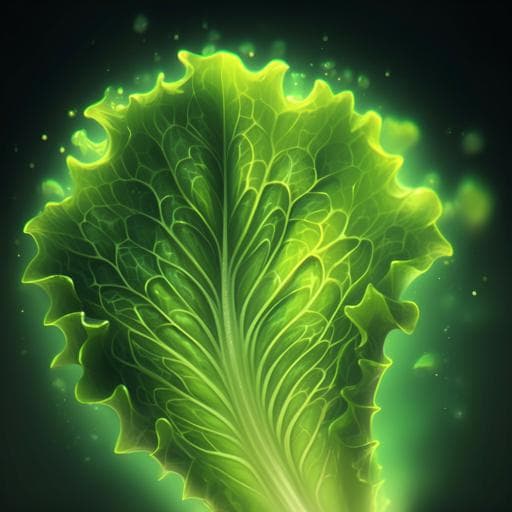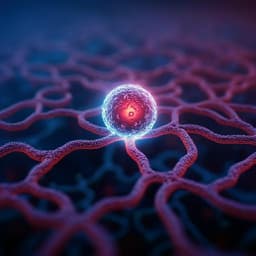
Biology
Revealing real-time 3D in vivo pathogen dynamics in plants by label-free optical coherence tomography
J. D. Wit, S. Tonn, et al.
This groundbreaking research by Jos de Wit and colleagues introduces a real-time method for visualizing pathogen dynamics in plants using label-free optical coherence tomography (OCT). By quantifying hyphal volume and length in lettuce downy mildew infection, this technique paves the way for innovative digital phenotyping and insights into pathogen vitality.
~3 min • Beginner • English
Introduction
Understanding how plant pathogens colonize host tissues requires non-destructive, longitudinal, high-resolution imaging in living plants. Existing approaches often depend on destructive histology or genetically engineered fluorescent pathogens, which are laborious, pathogen-specific, and not universally applicable. Conventional label-free methods (based on scattering or absorption) struggle to distinguish pathogen structures embedded in highly scattering plant tissue. Optical coherence tomography (OCT) provides label-free 3D imaging inside leaves but lacks contrast to separate similar-scattering structures. Dynamic OCT (dOCT) overcomes this by analyzing temporal fluctuations in OCT intensity originating from sub-cellular motion linked to metabolism, yielding functional, label-free contrast. Here, the authors show that dOCT, combined with leaf infiltration to reduce scattering, enables high-contrast in vivo visualization of diverse plant–pathogen systems and quantification of pathogen burden and growth dynamics in 3D.
Literature Review
The paper situates the work against prior in vivo imaging methods that rely on fluorescent markers in genetically transformed pathogens, which are challenging to implement for many species (especially biotrophs) and require specialized facilities. Label-free imaging modalities have been explored but typically lack sufficient contrast to resolve pathogen structures within highly scattering plant tissues. Conventional OCT has been used to image plant tissues, particularly with water infiltration to reduce scattering, but cannot reliably distinguish pathogens from plant cells due to similar scattering strengths. Dynamic OCT adds functional contrast by leveraging temporal fluctuations in scattering intensity arising from intracellular motions associated with metabolism and organelle dynamics, enabling cell-specific contrast without labels. This work extends dOCT to plant–pathogen imaging, demonstrating its applicability across different hosts and pathogens and positioning it as a platform for micro-phenotyping and longitudinal studies.
Methodology
- Sample preparation: Lettuce plants were grown at controlled conditions (21°C, long-day 16 h light). Leaf disks (10 mm) from five cultivars were placed abaxial side up on moist filter paper and inoculated with Bremia lactucae (race Bl33EU) either by spraying spore suspension (60 spores/µL; experiment 1) or by dabbing with infected cotyledons (experiment 2). Post-inoculation incubation at 16°C, short-day (9 h light). For experiment 1 (phenotyping; cultivars Bedford, Iceberg, Salinas), disks were sampled at 5 dpi, vacuum-infiltrated with tap water, and imaged with a surface water droplet to reduce reflection. For experiment 2 (longitudinal; Salinas), disks were imaged daily at beginning and end of light period. Additional imaging was performed on Arabidopsis infected with downy mildew, radish, and pepper roots with root-knot nematodes.
- Imaging setup: Spectral-domain OCT with broadband SLD centered at 840 nm, 50 nm bandwidth; axial resolution ~6 µm, lateral ~5 µm. Dynamic OCT acquisition used repeated B-scans at the same location over ~1.5 s to capture temporal fluctuations. The amplitude time-series per pixel was Fourier transformed to obtain an amplitude spectrum. Three frequency bands were defined: 0 Hz (static), 0.7–4.8 Hz (medium), and 5.5–16.4 Hz (high). The logarithm of the mean amplitude within each band provided the intensity for blue (0 Hz), green (0.7–4.8 Hz), and red (5.5–16.4 Hz), creating an RGB false-color dOCT image. Volumetric datasets were obtained by repeating across parallel frames. Leaves were infiltrated with water or perfluorodecalin to reduce scattering and improve imaging depth and contrast. Dynamic range limits for log compression were set per experiment based on noise floor and maximum signal, yielding ~62–64 dB ranges for bands (time-lapse ranges adjusted accordingly).
- Segmentation and quantification (experiment 1): To distinguish B. lactucae from plant tissue, a weighted combination of dOCT color channels (optimized using frequency-band weights; e.g., combining red, green, and blue channels) enhanced pathogen contrast. 3D Gaussian filtering (isotropic ~3 µm) reduced noise. Non-pathogenic structures (veins, stomata, highly active plant cells) were masked (manually curated after threshold determination). A global intensity threshold was applied, followed by small-object removal to yield clean hyphal segmentations. Hyphal volume was computed by summing voxel counts, and hyphal length by skeletonizing and summing skeleton voxels.
- Longitudinal analysis (experiment 2): For time-lapse series, a slightly lower threshold was used to capture most hyphae, and veins/stomata were filtered later using point cloud tools (CloudCompare) after manual cleanup. Growth trajectories were visualized by color-coding hyphae by time; hyphal volume over time was computed by point counts times voxel volume normalized by imaged area. Short-interval growth rates were estimated manually from image stacks in ImageJ.
- qPCR infection quantification: Independent TaqMan qPCR assays quantified relative pathogen DNA content from spray-inoculated leaves (race Bl33EU). Leaves were sampled at 7 dpi; DNA extracted (MagMAX Plant DNA kit with PVP for polyphenols; KingFisher platform). Pathogen-specific primers/probe targeted a mitochondrial gene; reactions run on StepOnePlus with standard cycling; Ct values used to compute relative pathogen DNA. qPCR provides whole-leaf averages, complementing localized dOCT measurements.
- Statistics: dOCT 3D stacks were expert-reviewed for infection presence. Differences in hyphal volumes and lengths among genotypes were tested using two-sided Mann–Whitney U tests (N = 16 per genotype), including zero-infection volumes. qPCR differences were assessed with two-sided Welch’s t-tests (N = 5 per genotype). Multiple-testing correction used the Benjamini–Hochberg method. Analyses performed in R 4.0.
Key Findings
- dOCT provides label-free, high-contrast 3D visualization of pathogen structures deep within plant tissues, distinguishing pathogen hyphae and haustoria from plant cells based on dynamic scattering fingerprints.
- In lettuce infected with B. lactucae, dOCT revealed detailed hyphal structures and haustoria within spongy mesophyll and could differentiate living (green, dynamic) vs dead (purple, static) plant cells associated with hypersensitive response.
- Living vs heat-killed spores were distinguished: living spores and germ tubes exhibited strong dynamic (green) signal, whereas heat-killed spores lacked dynamic fluctuations and appeared static (purple) in dOCT.
- The method generalized to multiple systems: clear dOCT contrast of downy mildew hyphae in Arabidopsis and radish, and structural contrast among nematode eggs, gelatinous matrix, nematode body, and plant root cells in pepper roots.
- Micro-phenotyping across lettuce genotypes showed differential colonization:
• Bedford: 4/6 volumes colonized; low infection with hyphal volume <0.2 mm³ and infection density ~3 mm/mm³.
• Iceberg: 6/6 volumes colonized; increased hyphal volume up to 0.61 mm³ and length up to 8 mm; differences vs Bedford not statistically significant (p = 0.34 for volume and length).
• Salsa: 15/16 volumes colonized; markedly higher burden with hyphal volume up to 2.3 mm³ and length up to 18 mm; significantly higher than Bedford and Iceberg (p < 0.001 reported in boxplot analysis).
- qPCR corroborated imaging-based trends: relative pathogen DNA mirrored dOCT-derived hyphal volume/length patterns, with Iceberg showing significantly higher levels than either comparator in the reported analysis (e.g., p = 2.90 × 10⁻²), noting qPCR averages whole-leaf infection while dOCT samples localized regions.
- Longitudinal imaging (Salinas): within single 12 h intervals, hyphae grew hundreds of micrometers; total hyphal volume increased rapidly, peaking around day 6 post inoculation. Short-interval tracking (10 min) captured tip growth with speeds ~54 µm/h, 10.5 µm/h, and 11.5 µm/h for three tips; subsequent imaging 15 h later showed continued growth and branching for selected tips.
- Functional dynamics: many hyphae lost medium-frequency dOCT signal after growth over ~1 day, consistent with redistribution of cytoplasm (e.g., towards sporangiospores), indicating physiological state changes that affect dOCT contrast and offering insights into infection-stage biology.
Discussion
The study demonstrates that dOCT yields functional, label-free contrast that separates pathogen structures from host tissues in vivo, enabling both structural and physiological assessment of infections in 3D. By imaging the pathogen directly rather than relying on secondary disease symptoms, dOCT improves accuracy and spatial resolution in quantifying disease severity and mapping infection heterogeneity. The agreement between dOCT-derived hyphal volume/length and qPCR-based pathogen DNA supports the validity of the imaging-derived metrics, while also highlighting complementary sampling scales (local versus whole-leaf). Longitudinal dOCT reveals temporal dynamics of hyphal growth, branching, and changes in intracellular activity, enabling direct observation of pathogen vitality and phase transitions during infection. These capabilities make dOCT a powerful tool for micro-phenotyping resistance traits, dissecting host responses (e.g., hypersensitive cell death vs alternative mechanisms), and studying diverse host–pathogen and parasite interactions. The findings suggest dOCT can inform breeding for resistance and evaluate interventions (e.g., fungicides or beneficial microbes) by providing real-time, non-destructive readouts of pathogen dynamics and host cell responses.
Conclusion
Dynamic OCT enables label-free, in vivo, 3D imaging of plant pathogens at cellular resolution with functional contrast, allowing quantification of pathogen burden, structure, and vitality over time. The method successfully visualized downy mildew hyphae and haustoria in leaf tissues, contrasted living vs dead cells and spores, generalized to other hosts and parasites, and supported micro-phenotyping across lettuce genotypes with corroboration by qPCR. Longitudinal imaging captured growth rates, branching, and physiological changes during infection, peaking around day 6 in the tested system. These advances position dOCT as a practical, non-destructive platform for high-throughput digital phenotyping and fundamental studies of host–pathogen interactions. Future work should improve segmentation with machine learning, extend imaging to whole plants or stabilized leaves over longer timescales, optimize infiltration/mounting strategies for gas-exchanging tissues, and integrate multimodal readouts to relate dynamic contrast to specific molecular processes.
Limitations
- Spatial resolution constraints (~5–6 µm) limit visualization of the smallest hyphae; OCT systems with lower resolution may fail to detect thin structures.
- Segmentation depends on global thresholds and manual masking of veins/stomata; chosen thresholds can remove up to ~35% of pathogen voxels, underestimating hyphal volume. Although consistent thresholds mitigate bias across genotypes, absolute quantification is conservative.
- Imaging quality relies on leaf infiltration with water or perfluorodecalin to reduce scattering; this can be challenging for gas-exchanging tissues and may require specialized mounting/incubation systems.
- Volume acquisition takes several minutes, which may limit temporal resolution and necessitate stabilization to avoid motion artifacts.
- dOCT signal can diminish in some hyphae over time due to physiological changes (e.g., cytoplasm redistribution), complicating consistent detection and quantification across stages.
- dOCT samples localized regions, whereas qPCR measures whole-leaf averages; spatial heterogeneity can cause discrepancies in direct comparisons.
- Some steps (e.g., manual cleanup of point clouds) introduce user-dependent variability; automated, robust segmentation/classification methods are needed.
Related Publications
Explore these studies to deepen your understanding of the subject.







